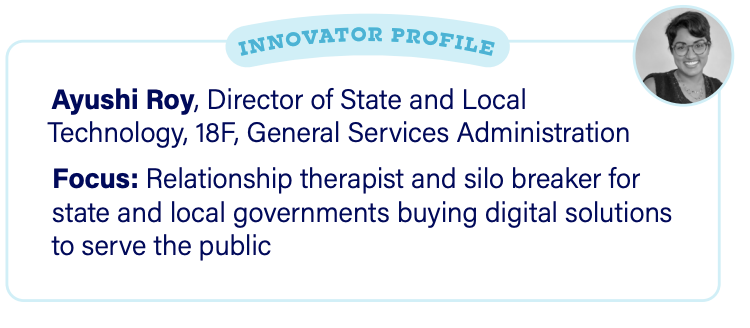Being in the trenches with agencies during the pandemic, as both a constituent and lifelong public servant, gave Ayushi Roy a new language to explain her work: “I do the thing that allows you to access government off-hours, and off-site” she said. “If you need the government before 9 a.m., after 5 p.m., or while sheltering in place, you can’t reach them unless they have a digital presence. That’s unacceptable.”
Roy, who most recently served as Director of State and Local Technology for the General Services Administration’s 18F, shared her lessons and optimism about the government creating digital front doors and reclaiming ownership of its innovation. (In January, Roy announced that she will be joining the federal government’s Technology Modernization Fund team.)
Digitize vs. modernize — there’s a difference
Making government digitally accessible outside standard business hours is not the final step. For example, governments must realize the value of modernizing beyond digitizing paperwork. That could mean reducing a clunky 20-page benefits form to an accessible and multilingual three-page one.
Create ship reports
What’s an artifact that you’re creating every two weeks? Software developers answer this question to share their progress. You can use ship reports to share what you did, what you couldn’t do and what you plan on doing next week. Anyone can use this method to share updates across teams.
Own acquisitions and products
Partnering with a vendor to solve an issue shouldn’t mean outsourcing ownership of the vision and mission, Roy said. Many times, government employees aren’t used to serving as the product owner. But states such as Rhode Island are changing that paradigm. It partnered with a large cloud vendor and led the charge for deciding what pieces of its system to modernize. Within 30 days, Rhode Island introduced a feature enabling constituents to track the status of their unemployment claims.
Redefine risks
Roy recalled asking a fellow public servant recently about their work and how they made unorthodox and risky workplace decisions to serve others during the pandemic. “They looked at me and they said, ‘This isn’t risky. My constituents not getting food is risky.’”
Be a silo breaker
The first step is realizing that what you’re doing is valuable to share, no matter how mundane it might seem, and then actually sharing it, says Roy. That could mean documenting what you’ve done or what you’ve noticed has worked for your team.
You can create informal gatherings internally within your organization, too. “I think there’s actually a really big gap around administrators of programs, secretaries of different departments or agencies gathering their own folks internally and having some sort of all-hands [meetings], where people cross-pollinate on the job knowledge, whether it’s every month or every quarter,” she said.
Don’t be a burden
“Never burden a constituent for the same information twice,” Roy said. “That is such a simple and yet powerful goal to address so many of the struggles that end up getting people kicked off things like their unemployment insurance checks. They get kicked off when we already have the information that we need to verify that they deserve the money.”






Leave a Reply
You must be logged in to post a comment.